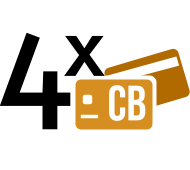WALDORF - IRIDIUM - 16 voice synthesizer
Waldorf Iridium has made the impossible possible. The powerful synthesis engine of the Waldorf Quantum is now available in a convenient format. Iridium follows in the footsteps of its big brother and offers all the synthesis elements of the Quantum in a rackable case.
The combination of five synthesis models, incredible flexibility and sound design options down to the smallest detail opens up new worlds of sound. The well-thought-out control concept, based on a logical layout and structured structure, allows you to create new sounds in no time. Packaged in a solid metal case with a high-quality finish, Iridium is ready to conquer recording studios and stages around the world.
Descendant of the famous PPG Wave, Iridium joins the milestones of Waldorf Music. Iridium follows the PPG legacy, but offers much more than its predecessor.
Five different synthesis models are available for each of the three oscillators:
Wave chart
Waveform (virtual analog)
Particles (sampling and granular sampling)
resonator
seeds
Kernel mode was already available with OS 2.0 for Waldorf Quantum. This extensive upgrade allows one oscillator to be transformed into up to six sub-oscillators. These can be linked together in any constellation via FM at audio rate. The features added in this upgrade alone would have been enough to create your own synthesizer. All these functions are now also included in Iridium.
Up to 7,000 patches can be stored in Iridium. Quantum patches can be loaded into Iridium and vice versa.
Iridium offers three filters per voice. Two in the Dual Filter section and one in the Digital Former. Different types of filters are available:
12 or 24 dB and low pass/high pass/band pass with optional saturation or dirty mode.
Waldorf Nave, Largo and PPG 3V filter models are also available.
The two filters in the Dual Filter section can be controlled independently or in different link modes.
The Digital Former includes all filter types and models in the Dual Dilter section, as well as some unusual filters such as Comb, Drive, Bitcrusher and more.
All filters always work in stereo mode. Stereo channels are kept as is throughout the signal path.
Up and down, front to back
Six envelopes, six LFOs and more modulation sources are waiting to be used in the Modulation Matrix's 40 slots. Each slot has an additional check amount. Almost any numeric value in Iridium can be used as a target. All sources and destinations can be used an unlimited number of times until the matrix is full.
If LFOs and envelopes are no longer enough, there is also the complex modulator. Another LFO or envelope can be created with a freely traceable line.
Complex but not complicated
A variety of settings are hidden beneath the surface of iridium. Nevertheless, Waldorf has managed to bring everything together into an operating concept that you can immediately understand. The most important parameters have their own button, the others are accessible via the touch screen and the encoders arranged around it. There are no in-depth menu structures here, but rather an operation that gets you to your objective quickly and is really fun.
A summary you can touch
There are 4x4 pad buttons on the front panel that prompt you to play. This can be used to trigger notes, chords, arpeggios and sequences with up to 32 steps for notes and parameter progressions. The seven encoders on the left and right of the screen allow direct access to settings on the touchscreen.
Everything at a glance
Iridium's large touchscreen keeps you informed and communicates with you. When you turn a knob, Iridium immediately displays the value change graphically on the screen. Filter curves move, particle grains change size, envelopes bend and much more:
Complex modulator curves can be drawn with your finger
Envelopes indicate where each voice currently is
Wavetables are displayed graphically in different views
VU meters display the volume of each voice
Different analyzers capture the audio signal at different points and display it graphically
Open to all
Two audio outputs output Iridium's signal, while two additional connectors record incoming signals and pass them to the synthesis engine. Four CV inputs, as well as gate in and trigger in, allow the connection of Eurorack modules, which are then present as modulation sources in the matrix. Clock In and Clock Out also allow synchronization with other devices.
Iridium has connectors for USB MIDI and DIN MIDI. Thanks to the controller port, Iridium can use other MIDI devices as hosts and exchange data with sticks and hard drives via USB. Iridium also has a micro SD slot.
Once again, Waldorf has confirmed its status among musicians around the world with a new and exciting synthesizer.
Iridium was designed, engineered and manufactured in Germany. All components used are of “industrial” quality and therefore guarantee a reliable synthesizer that will delight musicians for many years.
Features:
- 16 polyphonic, duo-timbral parts
- Compatible with the Waldorf Quantum synthesizer engine
- 3 oscillators
- Oscillator modes:
- Wave chart
- Waveform (VA)
- Particles (sampling and granular sampling)
- resonator
- Cores (up to 6 sub-oscillators can be connected via FM to audio flow)
- 3 stereo filters per voice
- Two digital filters
- 2 filters, independently adjustable
- 12/24dB LP/HP/LP in all combinations
- Nave, Largo, PPG, Quantum and StateVariable as models
- Old digital:
- Filter Waldorf Nave, Largo and PPG models in HP/LP/BP/Notch
- Comb filters
- Bitcrusher
- To drive
- Ring Mod
- Variable state
- Displaying the analyzer in filter view
- Filter curve moves with modulation (optional)
- Flexible routing options for filters with adjustable panning and levels
- Modulators:
- 6 envelopes
- 6 LFOs
- Complex modulator (freely drawable shape for LFO or envelope)
- Module Matrix
- 40 locations
- Quick assignment
- 1 additional control quantity per slot
- The same sources and destinations can be used as many times as necessary until the array is full
- Stamps:
- 4 × 4 silicone button with RGB lighting
- Pads can play notes, chords, arpeggios and sequences
- Lock mode
- Performance characteristics:
- Arpeggiator
- Step sequencer with up to 32 steps for notes and parameter lines
- Favorites screen for quick access to patches
- Modwheel, pitch bend and aftertouch can be controlled via the touchscreen
- Screen:
- Industrial-grade, extremely smooth touchscreen
- Fixes:
- Over 1000 factory sounds
- Capacity up to 7,000 patches (slot numbers 0000 to 9999 can be used)
- Patches from Quantum can be loaded into Iridium and vice versa
- Category filter for patch list
- 2 GB user sample memory
- Connections:
- 2x 6.3 mm jack output (TS)
- 2x 6.3mm jack input (TS)
- Headphone output with gain control
- MIDI DIN In/Out/Thru
- USBMIDI
- USB host for storage and MIDI devices
- MicroSD slot
- Kensington® Lock
- CV Connections:
- 4 CV inputs plus gate input, trigger input, clock input, clock output
- Inputs appear as sources in the Mod Matrix
- Miscellaneous:
- Robust metal housing with aluminum buttons
- Dimensions: 440 mm wide, 305 mm deep, 85 mm high (including controls)
- Weight: 5.4kg
- VESA 75 mount at the bottom (can be mounted on a standard VESA monitor mount)
- Adapter available for 19″ rack installation












